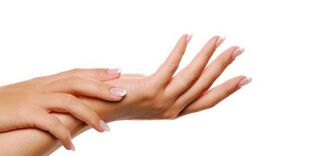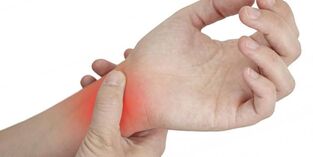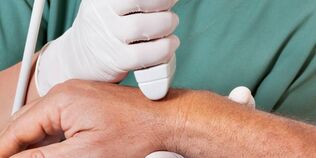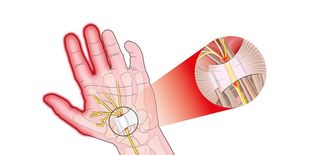
The fingers are the main tool, thanks to which we can carry out various work functions. It is therefore not surprising that when finger joints ache, it is difficult to perform your direct tasks or do your homework. Medical help is needed when the first painful sensations appear, otherwise, in advanced stages, serious consequences associated with the destruction of the joints are possible.
What to do if your finger joints hurt? It is necessary to contact a rheumatologist for examination and treatment as soon as possible. Only after the specialist has established the true cause of the pain and clarified the diagnosis, will he be able to choose an effective treatment regimen and prescribe the necessary medications.
Why finger joints hurt - the main reasons
There are many reasons that can trigger joint pain. The factors that cause pathological changes in the joints are:
- the influence of the external environment (for example, prolonged hypothermia, physical injury);
- professional factor associated with constant increase in stress in the joints;
- hormonal disorders;
- diseases of the immune and endocrine systems;
- hereditary factor;
- chronic infectious diseases.
The finger joints tend to hurt during pregnancy, and this condition is explained by the lack of calcium, which manifests itself more acutely during this period. An increase in the production of the hormone relaxin (which negatively affects the state of cartilage tissue), as well as a weakening of immunity associated with the restructuring of a woman's body during pregnancy, also play a role.

In addition, experts identify a range of diseases that lead to joint deformation and destruction and are accompanied by a characteristic symptom - pain. These are pathologies like:
- infectious arthritis; osteoarthritis;
- rheumatoid arthritis;
- psoriatic arthritis;
- rizarthrosis;
- drop;
- stenosing ligamentitis.
Let's look at the symptoms of diseases that cause joint damage and talk about the methods of diagnosis and treatment of these pathologies.
Finger joints hurt - what diseases can we talk about
The causes of pain in the finger joints are probably associated with one of the following diseases:
Rheumatoid arthritis is a chronic inflammatory autoimmune disease associated with injuries to the small joints of the arms and legs. The inflammatory process often affects the metacarpophalangeal joints of the middle and index fingers. If your fingers are swollen and your joints ache in the morning, this could be a sign of rheumatoid arthritis.

With the exacerbation of the inflammatory process, the skin over the joints swells, becomes red and hot to the touch, and dense nodules can be felt under it. The pain is so intense that the person cannot clench his fists. Symmetrical damage to the joints of both hands is characteristic of rheumatoid arthritis. The main symptom of the disease is morning joint stiffness, accompanied by increased pain.
The pain usually subsides at night. The danger of the disease is that the diagnosis is usually made in later stages, when the cartilage tissue has already been destroyed. If your joints ache and your fingers go numb, try not to postpone your doctor's appointment, otherwise a neglected inflammatory process can lead to deformed fingers and hands and end up in a disability.
Psoriatic arthritis
It is one of the forms of psoriasis, when, in addition to the skin manifestations, the distal joints (nails) of the finger phalanges are involved in the inflammatory process. At the same time, there is a change in its shape, they swell, swell, do not fold, the skin becomes red and inflamed and the fingers themselves become like sausages.
If the joints of the fingers of the right hand hurt (for example, the index finger and the little finger), then, by the way the joints of the fingers of the left hand hurt, a preliminary diagnosis can be made safely. In psoriatic arthritis, the inflammatory process will be asymmetrical, that is, the phalanges of the middle and ring fingers, on the other hand, will be affected.
Infectious and septic arthritis

These diseases usually occur with severe pain in the joints and worsening of the general condition, which is manifested by fever, chills, fever, symptoms of intoxication of the body.
Inflammation of a joint of a viral or bacterial nature is often associated with damage to a joint, where infectious agents penetrate through damage to the skin. But it is not uncommon and polyarthritis, when several joints are infected at the same time, in which case the inflammatory symptoms become especially pronounced.
Osteoarthritis
This disease is not inflammatory in nature and is manifested by joint deformity, its gradual thickening and limited mobility. If the finger joint hurts during flexion, the fingers take the form of a spindle with a characteristic thickening in the middle, which indicates the development of osteoarthritis.
The disease is typical in the elderly and is most often diagnosed in women after 40, which is associated with changes in hormone levels and the onset of menopause. In addition, professional factors, metabolic disorders and genetic predisposition can become the causes of osteoarthritis.
Drop
This disease is caused by metabolic disorders in which uric acid salts are deposited in the joints. Most of the time, gout is diagnosed in men aged 40 to 60 years and this is due to excessive consumption of fatty, spicy and salty foods, as well as alcohol addiction.
The lesion mainly affects the toes, but with an atypical course of the disease, the metacarpophalangeal joints of the thumb in the hands can also be affected. Gout pains are burning, unbearable. They differ in intensity and are accompanied by swelling and redness of the skin in the area of the affected joints.
Stenosing ligamentitis
This pathological condition looks like osteoarthritis or arthritis. Therefore, an X-ray examination is necessary to clarify the diagnosis. The main symptoms are: pain when flexing and extending the fingers, sometimes the joint can get stuck in a folded state and a certain effort must be applied to extend it.
Therefore, if the joint of the middle finger of the hand hurts and characteristic clicks are heard during its extension, you should consult a doctor as soon as possible. With the exacerbation of the inflammatory process, numbness of the fingers appears, a burning sensation, swelling, bluish skin tone in the affected area.
Rhizatrose

If the thumb joint in your hand hurts, this could be a sign of this pathology. The disease is usually associated with constant overload of the joint, penetration of infection or trauma. A common symptom is increased pain when performing certain actions, for example, turning door handles, turning the key in a lock, opening covers.
It is necessary to treat the disease as early as possible, otherwise the joint will be deformed and the pain will become constant, chasing the person even at rest. Over time, bone growth forms at the base of the thumb, which practically immobilizes the hand and leads to disability, as the slightest movement causes unbearable pain.
Carpal tunnel syndrome
This disorder is neurological in nature, as it develops as a result of compression of the median nerve that passes through the pulse. This is due to regular loads on the joints and ligaments of the hand. At risk are people who, by virtue of their profession, are forced to work constantly with their fingers (shorthand, computer technicians, musicians, artists). Pain is usually located in the thumb and forefinger area, and the accuracy of movements when performing certain actions is impaired. In addition, nerve compression can cause poor circulation and numbness in the fingers.
Clamping of vertebral nerves, bursitis, rheumatological pathologies, unhealthy lifestyle and other factors can cause pain in the joints of the hands. It is important to pay attention to alarming symptoms in a timely manner and seek qualified help.
Which doctor will help if your finger joints hurt?
In the initial stage, you can make an appointment with a therapist who, after making an anamnesis, will refer you to a restricted specialist (doctor - rheumatologist). It is this specialist who deals with joint diseases, he will give the necessary assistance and make an accurate diagnosis.
In addition, you may need to consult a surgeon or neurologist. Based on the result of the examination, the doctor will prescribe the necessary treatment, taking into account the cause of the joint injury, the severity of the symptoms, the possible contraindications and the individual characteristics of the patient.
Diagnosis

The activities necessary for the correct diagnosis are visual examination, laboratory tests of blood, urine and referral of the patient for radiographic examination. An X-ray of the hands usually gives the necessary idea of the nature of the pathology and the degree of joint damage.
To obtain the most complete information about the nature of the pain and the causes of the inflammatory process, the doctor can refer the patient for an ultrasound, computed tomography (CT) or magnetic resonance imaging (MRI). These are the most modern and informative research methods that allow to identify the smallest changes in the initial stages of the disease and help to prevent its further development and serious consequences associated with deformation and destruction of the joints.
Sometimes, if you suspect gout, a special blood test is done to check your uric acid level. To identify the pathological changes that occur in bone tissue, a contrast discography procedure is used with a special dye.
The most effective diagnostic method today is electrospondylography, which started to be used several years ago. This procedure allows you to examine the parts of the spine that are responsible for the functioning of the upper extremities and to identify any pathological deviations from the norm in the early stages.
Treatment methods
After the diagnosis is made, the doctor will select a therapy regimen depending on what causes pathological changes in the joints. The principles of treatment, if the joints in the hands hurt, are based on the use of medications, physiotherapeutic procedures, therapeutic exercises, adequacy of the diet and lifestyle.
If there is an inflammatory process, the doctor will prescribe pain relievers, hormonal or non-steroidal anti-inflammatory drugs. They can be systemic medications (oral pills) or external medications in the form of ointments, creams, sprays, which help to quickly relieve pain. The doctor may prescribe hormonal agents in the form of injections into the joint cavity for severe pain. These procedures quickly relieve the patient's condition and contribute to the transition of the disease to a state of remission. In infectious arthritis, antibacterial agents are prescribed.
The development of degenerative diseases of the musculoskeletal system is facilitated by a decrease in the level of chondroitin in the cartilage tissue of the joint. Therefore, patients are prescribed drugs - chondroprotective, which can prevent the destruction of the joint and restore the structure of the cartilage tissue.
Physiotherapy

Physiotherapy methods are an important aspect of complex treatment. This includes novocaine electrophoresis, UHF, magnetotherapy, laser treatment, amplipulse therapy, phonophoresis. The number of sessions and the duration of treatment are determined by the doctor individually.
Therapeutic exercises and massages are necessary to restore joint mobility, improve blood circulation and metabolic processes. During periods of remission of the disease, the patient is recommended to have balneotherapy sessions (treatment with natural mud), manual therapy. A very good effect is provided by a spa treatment with a trip to favorable climatic zones.
In addition, the patient is advised to lead a healthy lifestyle, stop drinking and smoking and follow some dietary restrictions. It is advisable to completely exclude fatty meat and fish from the diet, to abandon dairy products and high-fat fermented dairy products. Smoked, spicy, salted meats, pickled dishes, spices, mayonnaise, citrus fruits, roasts, strong tea and coffee are prohibited. Do not eat foods that contain oxalic acid (rhubarb, sorrel, spinach).
The daily menu should contain low-fat sour milk drinks, herbs, fresh vegetable salads with vegetable oil, lean meat, seafood and low-fat fish. Fruits, berries, nuts, ginger, figs, natural vegetable oils with a high content of omega fatty acids (especially flaxseed oil and olive oil) are useful. A higher intake regime of up to 1. 5-5 liters of drinking water per day is recommended.
Alternative remedies
Today, on the shelves of pharmacies, you will find many innovative products developed for the treatment of joint pain. The most suitable medication will be selected by a specialist.
Prescriptions for traditional medicines

Folk remedies for pain in the finger joints complement the main treatment regimen, bring relief and accelerate recovery.
- In case of exacerbation of the inflammatory process, a gauze napkin dipped in apple cider or table vinegar can be applied to the painful joint. This will help to reduce pain, relieve burning and swelling. You can make compresses with roasted onions, boiled potatoes or by heating with hot sea salt and rubbing with fir oil.
- Roasted onion ointment. The onion head is roasted in the oven, cooled and chopped. The resulting mass is mixed with an equal amount of liquid honey and vegetable oil (1 teaspoon each), adds 10 g of beeswax and 20 g of dry grass with a golden mustache. The composition is boiled in a water bath, stirring continuously, until the mixture is homogeneous and thickens. The finished ointment is removed from the fire and slightly cooled. In a warm form, rub on the aching joints, put cotton gloves on top. The procedure is best performed at night.
- Ointment of honey and mustard. To prepare the ointment, mix 5 g of mustard with 1 tsp. honey, add a large spoon of olive oil and 20 g of dry white hellebore leaves. Then, the mixture is evaporated in a water bath to a thick and homogeneous state, cooled and used in the daily treatment of diseased joints.
- Compresses. Compresses based on natural ingredients play a special role in relieving pain and inflammation. You can boil potato tubers, crush, wrap very hot in a gauze napkin and apply to the affected area. The same therapeutic effect is achieved by common salt, preheated in a pan. Dry heat can help to relieve pain and reduce inflammation. The use of common chalk as a compress is recommended. It should be crushed, mixed with any fermented milk drink, soaked in a gauze napkin and compressed overnight. Steamed oats can also be used for the same purpose.
- Lilac dye. The decoctions and infusions of medicinal herbs have a good anti-inflammatory effect, improve blood circulation and restore the mobility of the affected joints. The tincture is prepared in the spring, as soon as the lilac blooms. Collect the inflorescences, fill them with alcohol or vodka and insist in a dark place for 3 weeks. The final dye is filtered and rubbed on the aching joints, after which the gloves are put on to keep the hands warm.
There are many popular recipes for treating joint pain. In order for its use to be beneficial, be sure to consult your doctor first and obtain his approval for the procedure.




























